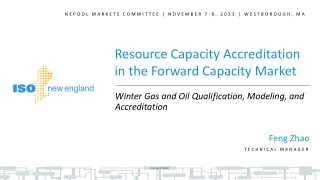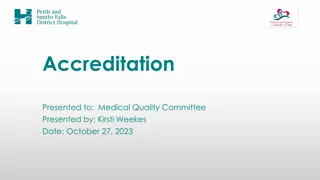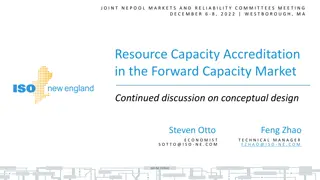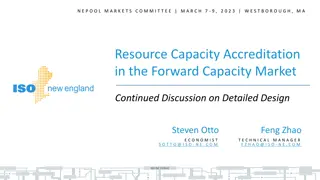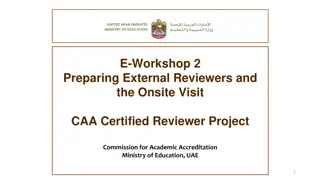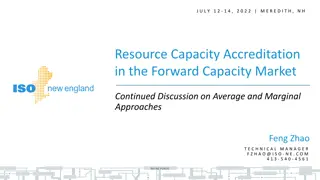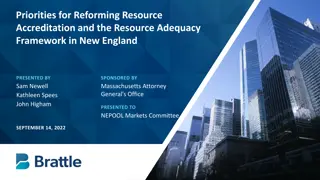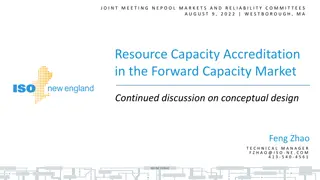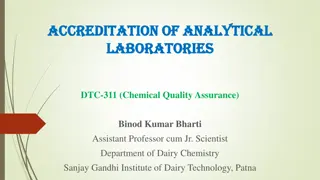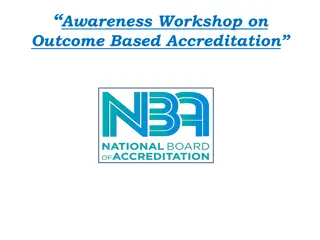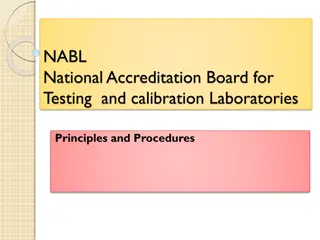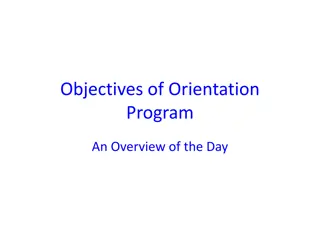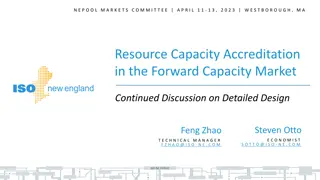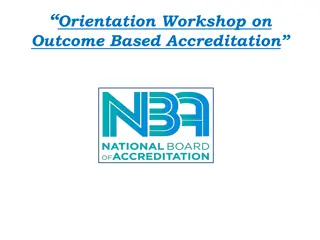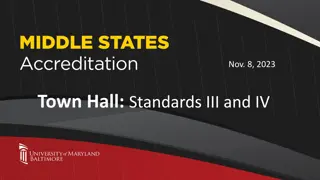Resource Capacity Accreditation in Forward Capacity Market Discussions
Discussion on the conceptual design for Resource Capacity Accreditation in the Forward Capacity Market, focusing on improvements to accreditation processes to support a reliable transition to clean energy. The presentation outlines methodologies to accredit resource contributions, commitments to proposed improvements, and upcoming meeting agendas.
Download Presentation

Please find below an Image/Link to download the presentation.
The content on the website is provided AS IS for your information and personal use only. It may not be sold, licensed, or shared on other websites without obtaining consent from the author. Download presentation by click this link. If you encounter any issues during the download, it is possible that the publisher has removed the file from their server.
E N D
Presentation Transcript
J O I N T M E E T I N G N E P O O L M A R K E T S A N D R E L I A B I L I T Y C O M M I T T E E S S E P T E M B E R 1 3 - 1 4 , 2 0 2 2 | W E S T B O R O U G H , M A Resource Capacity Accreditation in the Forward Capacity Market Continued discussion on conceptual design Feng Zhao T E C H N I C A L M A N A G E R F Z H A O @ I S O - N E . C O M 4 1 3 - 5 4 0 - 4 5 6 1 ISO-NE PUBLIC
WMPP ID: 157 Resource Capacity Accreditation in the Forward Capacity Market Proposed Effective Date: FCA 19 The Resource Capacity Accreditation (RCA) project proposes improvements to ISO-NE s accreditation processes in the Forward Capacity Market (FCM) to further support a reliable, clean-energy transition by implementing methodologies that will more appropriately accredit resource contributions to resource adequacy as the resource mix transforms The ISO has made a commitment to FERC to file proposed improvements in time for FCA 19 In July and August, the ISO presented main components of its conceptual design and illustrated the design with a simple example This presentation introduces the conforming changes to the demand curves A separate presentation has more details on the proposed resource model enhancements Graphs and numerical examples do not reflect estimates of the impacts of potential reforms but are merely stylized examples ISO-NE PUBLIC 2
WMPP ID: 157 Resource Capacity Accreditation in the Forward Capacity Market Proposed Effective Date: FCA 19 At the June through August meetings, the ISO and stakeholders discussed average and marginal accreditation approaches At the October meeting, the ISO will address remaining questions on average and marginal accreditation approaches and wrap up this discussion area ISO-NE PUBLIC 3
WMPP ID: 157 Resource Capacity Accreditation in the Forward Capacity Market Proposed Effective Date: FCA 19 Outline of today s discussion: Review of the MRI-based conceptual design (slides 6-10) Capacity demand curves under RCA (slides 12-23) Conclusion (slide 25) Stakeholder Schedule (slides 26-31) ISO-NE PUBLIC 4
REVIEW OF MRI-BASED CONCEPTUAL DESIGN ISO-NE PUBLIC ISO-NE PUBLIC 5
Presented August MC /RC Meeting RCA Improvements Opportunity #1: Current capacity accreditation framework can be improved to reflect different resource contributions toward resource adequacy. These adjustments will better yield accredited capacity that is substitutable between resources, which is beneficial as unique resource types enter the market RCA will implement a MRI framework that improves resource substitutability Opportunity #2: Current resource adequacy assessment process can be improved to better reflect resources expected performance and reliability contributions as the resource mix changes RCA will improve resource adequacy assessment modelsfor more accurate calculation of resource accreditation values ISO-NE PUBLIC 6
Presented August MC /RC Meeting MRI-based Capacity Accreditation Framework As explained in July, there are several key components of the MRI-based capacity accreditation proposal, which are summarized below: Each resource s Marginal Reliability Impact (MRI), in hours/year, represents the Expected Unserved Energy (EUE) change over a small increase of Qualified Capacity (QC): MRI= EUE/ QC Each resource s relativeMarginal Reliability Impact (rMRI) to perfect capacity is a ratio (no units): rMRI = MRI/MRIperfect Each resource s new accredited capacity, Qualified MRI Capacity (QMRIC), will be calculated in MW: QMRIC = QC rMRI rMRI Qualified Capacity (QC) Qualified MRIC (QMRIC) ISO-NE PUBLIC 7
Presented August MC /RC Meeting MRI-based Capacity Accreditation, cont. Under MRI-based accreditation, two obligations are produced subsequent to market clearing The new Capacity Supply Obligation (CSO) or cleared QMRIC, a market quantity used for capacity base payment, etc. The Effective CSO (ECSO) associated with CSO, a physical representation of CSO used for FCM reliability reviews, etc. FCM Clearing Physical & market quantity Current: CSO QC Physical quantity QC ECSO New: 1/rMRI rMRI FCM Clearing Market quantity CSO QMRIC ISO-NE PUBLIC 8
Presented August MC /RC Meeting Resource Adequacy Assessment Model Enhancement Resource Adequacy Assessment (RAA) models will be enhanced to allow more accurate calculation of resources MRI The current load shape in RAA will be enhanced with a composite load shape reflecting representative summer and winter weather conditions Intermittent resource models such as solar and wind will be enhanced with hourly output profiles Energy storage resource models will be enhanced Gas-only resource models will be improved by incorporating gas supply constraints More details about proposed model enhancements will be discussed in a separate presentation ISO-NE PUBLIC 9
Presented August MC /RC Meeting Capacity Demand Curves The ISO has already applied the MRI concept to its capacity demand curves MRI-based Zonal Demand Curves By applying the same MRI concept and consistent resource mix assumptions to both supply and demand sides of FCM, the supply and demand will properly align MRI-based Demand Curve MRI-based Resource QC accreditation Accreditation ISO-NE PUBLIC 10
CAPACITY DEMAND CURVES UNDER RCA ISO-NE PUBLIC ISO-NE PUBLIC 11
Roadmap In August, the ISO used a fixed capacity demand to illustrate its conceptual design for simplicity of the small example The actual design uses capacity demand curves The following slides introduce the conforming changes to the capacity demand curves under RCA at the conceptual level Review of current QC-based capacity demand curves QMRIC-based capacity demand curves under the MRI framework Translating QC demand curves to QMRIC demand curves ISO-NE PUBLIC 12
CAPACITY DEMAND CURVES UNDER RCA Current QC-based Capacity Demand Curves ISO-NE PUBLIC ISO-NE PUBLIC 13
Types of Capacity Demand Curve ISO-NE currently models 3 types of demand curves in its FCM: System capacity demand curve Import-zone capacity demand curve Export-zone capacity demand curve The zone configuration is determined prior to the auction based on transmission analysis The FCM produces cascaded capacity clearing prices An import zone clearing price is no less than the Rest of Pool (ROP) capacity zone clearing price An export zone clearing price is no more than the ROP clearing price ISO-NE PUBLIC 14
Illustration of Current QC Demand Curves The three types of demand curves are illustrated below $/kw-m $/kw-m $/kw-m Import zone demand curve System demand curve Export zone demand curve System QC (MW) Import zone QC (MW) Export zone QC (MW) These curves are for illustration purpose only; details of the current QC demand curve construction can be found in FCM 101: Lesson 4 Capacity Zones and Demand Curves ISO-NE PUBLIC 15
Current QC-based Capacity Demand Curve Current QC demand curve is the demand MRI function (in term of total QCz of the system or zone) multiplied by the scaling factor : ? ????(???)z represents a system or zone is determined such that at the 1-in-10 criterion or Net ICR, the system marginal reliability benefit equals the marginal cost of capacity or Net Cost of New Entry (Net CONE), i.e., ? = ???????/??????(??????) For any total QCz in the system or zone, MRIz(QCz) represents the marginal reliability impact, measured by EUE reduction, with respect to a small change to QCz, i.e., MRIz = EUE/ QCz(same concept for resource MRIs) ISO-NE PUBLIC 16
CAPACITY DEMAND CURVES UNDER RCA QMRIC-based Capacity Demand Curves ISO-NE PUBLIC ISO-NE PUBLIC 17
QMRIC Demand Curves Under The MRI Framework Under the MRI framework, the definition of capacity demand curves remains the same, i.e., the marginal reliability benefit of increasing one MW of capacity in a system or zone With MRI-based accreditation, capacity in the system or zone is measured in QMRIC (instead of QC) For any total QMRICz in the system or zone, the demand MRI function represents the EUE reduction with respect to a small change to the total QMRICz in the system or zone, i.e., ???? ?????? = ???/ ?????? ISO-NE PUBLIC 18
QMRIC Demand Curves Under The MRI Framework, cont. With the updated demand curve scaling factor , the QMRIC demand curve for a system or zone under the MRI design is ? ???? ?????? z represents a system or zone is determined such that at 1-in-10 criterion, the system marginal reliability benefit equals the marginal cost of capacity The definition of capacity demand curve did not change with QMRIC ISO-NE PUBLIC 19
CAPACITY DEMAND CURVES UNDER RCA Translate QC Demand Curves to QMRIC Demand Curves ISO-NE PUBLIC ISO-NE PUBLIC 20
Relationship Between Total QC and Total QMRIC The current QC-based demand curve and the QMRIC-based demand curve have the same definition, except for different measures (QC or QMRIC) of total capacity in a system or zone For a system or zone, its total QC and total QMRIC have the following relationship: ??????= ??? ????? rMRIz is the relative MRI of the mixed resources in the system or zone, or QC-weighted average rMRI of the mixed resources This relationship is used to translate QC demand curves to QMRIC demand curves ISO-NE PUBLIC 21
Constructing QMRIC-based Demand Curve From QC- based Demand Curve QMRIC demand curve can be constructed by translating the QC-based demand MRI function to QMRIC-based function and by updating the parameter ? to ? Each point (???, ????) on the QC-based demand MRI function for a system or zone is translated to the point (??????, ???? ) on the QMRIC-based demand MRI function by simple scaling, i.e., ??????= ??? ????? and ???? = ????/????? (See Appendix) ? is updated with the ??????? and at-criterion ?????? under the MRI design (See Appendix) values ISO-NE PUBLIC 22
Stylized Example Illustrating the Construction of QMRIC-based Demand Curve Suppose that the current QC-based demand MRI function is y = 1 ? and the demand curve scaling factor is 1 The QC-based demand curve is 1 (1 ?) as illustrated in the upper figure Suppose that the rMRIz of the resource mix in the system or zone is 0.8 and the updated demand curve scaling factor =1 The QMRIC-based demand MRI function is ? = 1 0.8(1 The QMRIC-based demand curve is 1 as illustrated in the lower figure $/kw-m 1 (1 ?) QC (MW) $/kw-m 1 ? 1 1 ? 0.8) 0.8 0.8 ? 0.8 1 1 0.8 QMRIC (MW) ISO-NE PUBLIC 23
CONCLUSION ISO-NE PUBLIC ISO-NE PUBLIC 24
Key Takeaways Under the MRI-based accreditation, supply and demand quantities of capacity are both measured in QMRIC The total QMRIC in a system or zone can be translated from the total QC using rMRI of resource mix in the system or zone QMRIC-based demand curve can be translated from the QC- based demand curve by scaling both quantity and price ISO-NE PUBLIC 25
STAKEHOLDER SCHEDULE ISO-NE PUBLIC ISO-NE PUBLIC 26
RCA Road Map MRI Framework The below road map provides a projection of when committee discussions will begin on topics related to the MRI framework: RCA Topic Projected Start of Committee Discussions Ongoing Ongoing Average vs. Marginal Accreditation Approaches Incorporate MRI Construct Integrating Gas Limitations into Resource Adequacy: Framework Introduction Gas Resource Accreditation Method November 2022 December 2022 Conforming Changes: Demand Curves (including CONE/Net CONE) FCA & Reconfiguration Auctions Obligations & Settlement Auction Parameters (e.g. DDBT) Reliability Reviews (e.g. utilize ECSO) Commercial Demonstration Ongoing October 2022 October 2022 November 2022 December 2022 December 2022 ISO-NE PUBLIC 27
Stakeholder Process - Overview There are several broad phases laid out for this proposal in the stakeholder process: Background, Conceptual Design, & Education: June 2022 October 2022 Detailed Design: November 2022 January 2023 Finalize Design & Review Tariff Language: February 2023 April 2023 Voting: May 2023 (Technical Committees) and June 2023 (Participants Committee) Through at least the conceptual design phase, the content will primarily be delivered during the MC with the RC jointly invited to discuss the RCA proposal As needed, additional joint MC/RC meetings would be held during the regularly scheduled RC to continue discussions of material that were not completed during the regular joint MC/RC meeting Starting likely with the detailed design phase, the MC and RC will meet separately and discuss distinct content under their committee s purview. The MC and RC are each invited to continue to participate in each other s ongoing discussions and review on the RCA proposal At the next meeting in October, topics include: Addressing remaining follow-up questions on average vs. marginal accreditation approaches Further discussion on ISO s conceptual design relating to the MRI framework and resource modeling enhancements Review the ISO s proposed impact assessment scope and scenarios During the detailed design phase, related conforming changes needed to implement the RCA proposal will be introduced ISO-NE PUBLIC 28
Stakeholder Schedule Conceptual Design Phase JUNE 2022 T W 1 7 8 S M T 2 9 F 3 10 11 S 4 Joint Markets and Reliability Committees MC Meeting Dates: June 7-8, 2022 (with joint RC during RCA components)(link to materials) Posting Materials Beginning: June 1, 2022 Topics: Review background and discuss opportunities for adjusting the way resources are accredited in the FCM to support a reliable, clean- energy transition 5 12 13 14 15 16 17 18 19 20 21 22 23 24 25 26 27 28 29 30 6 JULY 2022 T W S M T F 1 8 S 2 9 Joint Markets and Reliability Committees MC Meeting Dates: July 12-14, 2022 (with joint RC during RCA components) (link to materials) Posting Materials Beginning: July 6, 2022 Topics: Discussion of ISO's design objectives and conceptual design 3 10 11 12 13 14 15 16 17 18 19 20 21 22 23 24 25 26 27 28 29 30 31 4 5 6 7 Stakeholders should submit additional clarifying questions on average and marginal approaches to the MC Secretary by June 24, 2022 AUGUST 2022 T W 2 3 9 10 11 12 13 14 15 16 17 18 19 20 21 22 23 24 25 26 27 28 29 30 31 S M 1 8 T 4 F 5 S 6 Joint Markets and Reliability Committees MC Meeting Dates: August 9-10, 2022 (with joint RC during RCA components) (link to materials) Posting Materials Beginning: August 3, 2022 Topics: Continue discussion of ISO's conceptual design 7 Stakeholders should submit additional clarifying questions on average and marginal approaches or the conceptual design to the MC Secretary by July 22, 2022 ISO-NE PUBLIC 29
Stakeholder Schedule Conceptual Design Phase, cont. SEPTEMBER 2022 S M T W T Joint Markets and Reliability Committees MC Meeting Dates: September 13-14, 2022 (with joint RC during RCA components) Posting Materials Beginning: September 7, 2022 Topics: Continue discussion of conceptual design and review proposed impact assessment approach F 2 9 10 S 3 1 8 4 11 12 13 14 15 16 17 18 19 20 21 22 23 24 25 26 27 28 29 30 5 6 7 Stakeholders should submit remaining clarifying questions on average and marginal approaches or additional questions on the conceptual design to the MC Secretary by August 22, 2022 Additional Joint Markets and Reliability Committees RC Meeting Date: September 20, 2022 (with joint MC during RCA components) Posting Materials Beginning: September 14, 2022 Topics: As needed, continue discussion of ISO materials from September 13-14 Joint MC/RC on ISO's conceptual design and proposed impact assessment approach OCTOBER 2022 S M T W T Joint Markets and Reliability Committees MC Meeting Dates: October 12-13, 2022 (with joint RC during RCA components) Posting Materials Beginning: October 5, 2022 Topics: Continue discussion of conceptual design and proposed impact assessment scope and scenarios Stakeholders should submit remaining clarifying questions on average and marginal approaches, additional questions on the conceptual design, and any feedback on the Impact Assessment to the MC Secretary by September 26, 2022. Additional Joint Markets and Reliability Committees RC Meeting Date: October 18, 2022 (with joint MC during RCA components) Posting Materials Beginning: October 12, 2022 Topics: As needed, continue discussion of ISO materials from October 12-13 Joint MC/RC on ISO's conceptual design and proposed impact assessment scope and scenarios F S 1 8 2 9 10 11 12 13 14 15 16 17 18 19 20 21 22 23 24 25 26 27 28 29 30 31 3 4 5 6 7 ISO-NE PUBLIC 30
Stakeholder Schedule Detailed Design Phase NOVEMBER 2022 M T W 1 7 8 13 14 15 16 17 18 19 20 21 22 23 24 25 26 27 28 29 30 Markets Committee MC Meeting Dates: November 8-9, 2022 (RC invited to participate in RCA discussions) Posting Materials Beginning: November 2, 2022 Topic: Review detailed design and finalize impact assessment scenarios S T 3 10 11 12 F 4 S 5 2 9 6 Reliability Committee RC Meeting Date: November 16, 2022 (MC invited to participate in RCA discussions) Posting Materials Beginning: November 9, 2022 Topic: Review detailed design DECEMBER 2022 M T W Markets Committee MC Meeting Dates: December 6-8, 2022 (RC invited to participate in RCA discussions) Posting Materials Beginning: November 30, 2022 Topic: Continue review of detailed design S T 1 8 F 2 9 S 3 10 4 11 12 13 14 15 16 17 18 19 20 21 22 23 24 25 26 27 28 29 30 31 5 6 7 Reliability Committee RC Meeting Date: December 14, 2022 (MC invited to participate in RCA discussions) Posting Materials Beginning: December 8, 2022 Topic: Continue review of detailed design JANUARY 2023 M T 2 3 9 10 11 12 13 14 15 16 17 18 19 20 21 22 23 24 25 26 27 28 29 30 31 Markets Committee MC Meeting Dates: January, 2023 (RC invited to participate in RCA discussions) Posting Materials Beginning: January, 2023 Topic: Continue review of detailed design. Review initial Impact Assessment results. Stakeholders interested in proposing conceptual amendments should contact the MC secretary for time on the agenda S 1 8 W 4 T 5 F 6 S 7 Reliability Committee RC Meeting Date: January, 2023 (MC invited to participate in RCA discussions) Posting Materials Beginning: January, 2023 Topic: Continue review of detailed design. Stakeholders interested in proposing conceptual amendments should contact the RC secretary for time on the agenda ISO-NE PUBLIC 31 Note: Detailed information will be shared once the dates for the 2023 NEPOOL calendar are established
Appendix: Deriving QMRIC-based Demand MRI Curve From QC-based Demand MRI Curve Given total ?????? in a system or zone, ???? ?????? represents the EUE reduction from increasing QMRICz by 1 MW 1 MW increase of QMRICz translates to (1/rMRIz) MW increase of QCz since QMRICz = rMRIz QCz Since the EUE reduction from 1 MW increase of QCz is MRIz(QCz), the EUE reduction from 1 MW increase of QMRICz, or (1/rMRIz) MW increase of QCz, is (1/rMRIz) MRIz(QCz) Thus, ???? ?????? can be represented as (1/rMRIz) MRIz(QCz) or (1/rMRIz) MRIz(??????/rMRIz), i.e., ???? ?????? = 1/????? ????(??????/?????) ISO-NE PUBLIC 33
Appendix: Updating The Demand Curve Scaling Factor The current demand curve scaling factor is calculated as ???????/ ??????(??_?????????) Net CONE is calculated as PPR H BR, where PPR is the capacity Performance Payment Rate (PPR), H is the number of estimated annual scarcity hours, and BR is the balancing ratio of (Load + Reserve Requirement) / Net ICR The at-criterion ?????? is obtained from the QC-based demand MRI function The demand curve scaling factor under the MRI design is calculated as ??????? /?????? (??_?????????) Net CONE is calculated as PPR H BR where BR is (Load + Reserve Requirement) / At-criterion Capacity Requirement The at-criterion ?????? is obtained from the QMRIC-based demand MRI function ISO-NE PUBLIC 34







